| Back to Back Issues Page |
 |
|
Bangkok Travelbug June 2017 Ancient kilns on the Maenam Noi Singburi May 30, 2017 |
| Hello
Maenam Noi Singburi The Maenam Noi branches off from the Chao Phraya River about 5 km downstream from Chai Nat City north of Singburi. The river meanders through the provinces of Chai Nai, Singburi, Ang Thong and Ayutthaya before re-joining the Chao Phraya at Bang Sai, a distance of 170 km. Noi River was one of the original courses of the Chao Phraya but owing to heavy silting, the river broke its banks in the mid-1800s and took its present course. The river plays an important role in the irrigation of the Chao Phraya basin after it was dredged, linked to other canals and had four sluice gates installed to regulate the flow of water. The clay on the banks upstream is also very malleable and became a centre for a thriving pottery industry six centuries ago. 
Old jars and pots from the Maenam Noi kilns Contents The ancient art of pottery The ancient kilns in Si Satchanalai, Sukhothai have been producing the famous Sangkhalok pottery since the 13th C. Please see Ancient kilns in Ban Ko Noi, Si Satchanalai With the emergence of Ayutthaya in the 14th C, another centre for pottery started on the upper reaches of the Noi River in Singburi and potters from Sukhothai migrated to this area to continue their craft. 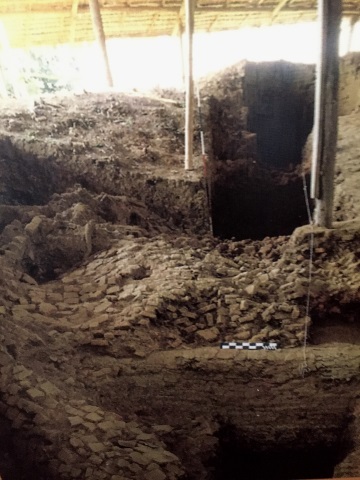
An excavated kiln in Maenam Noi The rich clay on the Maenam Noi was a main factor, abundance of trees to provide fuel for the kilns another and lastly the ease of transportation of the finished products downriver. The products of this industry consist of various types of containers like jars (hai) , bowls, basins, mortars, pots. In addition, the potters also produced building accessories like water pipes, floor tiles, stoves, decorative sculptures for buildings and incredibly, cannonballs as well! 
Old jars recovered from the excavation One type of containers produced is the distinctive jar with four lugs just below the rim, (hai si hu), the unmistakable mark of the Maenam Noi kilns. 
"Hai si hu" – the four-lug jars The Maenam Noi kilns produced the largest number of jars, pots and other containers in the kingdom and made an important contribution to the foreign trade and economy of Ayutthaya. When King Prasat Thong of Ayutthaya (1628 – 1656) built Chai Wattanaram in 1630, tiles from the Maenam Noi kilns were used to pave the floor. 
Ruins of Wat Chai Wattanaram, Ayutthaya King Narai’s (1656 – 1688) palace, (Phra Narai Ratchaniwet) in Lopburi, was supplied with water through these pipes linking the Sup Lek basin 15 km away to the water tank within the palace grounds. 
Ruins of the water tank in King Narai’s Palace, Lopburi Pottery recovered from old shipwrecks in the Gulf of Thailand in 1974 show evidence of pottery not only from Sukhothai but from Maenam Noi as well. Contents Tour of kilns on the Maenam Noi Our first stop during our visit to the Maenam Noi kilns was the information centre. This was actually a display area for the various types of pottery with information boards in English and Thai to provide the historical background. 
Exhibits in the information centre These two charts illustrate the pottery manufacturing process in those days. 

The pottery manufacturing-process After viewing the information centre we met Lung (uncle) the person in charge of the kiln site and museum and we were in for a surprise. The displays we saw were reproductions, the real ones were kept somewhere else! But in the end, we were not disappointed, as you shall see. Lung took us on a tour of the temple grounds starting with the site of the ancient kilns. Excavation of the area started in 1988. The original kiln site covered two sq. km, unfortunately new developments and buildings have destroyed many of them. Presently only five kilns remain in an area about 3,000 sq. m. These kilns are the largest kilns to be discovered in Thailand. When Lung was a young boy in the days before the excavation, he used to play in the temple grounds with its well-kept garden under the shade of trees. Little was he aware of the historical treasures under his feet, or that one day his uncle would be the abbot of the temple and invite him to look after these artefacts. The dating of these kilns is based on the bricks used in the construction of an old prang (a rectangular based tower that tapers upwards and looks like a cob of corn) in the temple grounds. 
15 m prang dating back to the early Ayutthaya period Archaeologists have estimated this prang to be built around the period 1457 – 1557 AD. The kilns are assumed to be of the same vintage because of similar bricks found in the kilns. These are cross draft kilns which are oval in shape with arched roofs and divided into three compartments, a fire box fuelled by wood, a fire chamber for the pottery and a chimney. 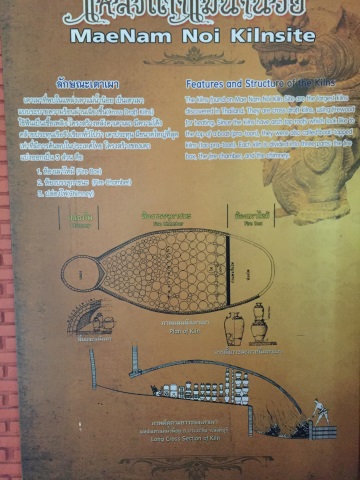
Plan view and cross section of a kiln Kilns 1 & 5 were excavated in 1989 and had dimensions of 16 m long, 5.4 m wide with the chimney 2 m high. Kiln 3 was discovered in the latest excavation in 1994. 
Kilns 1 & 5 
Kiln 3 with a Tamarind tree growing over it 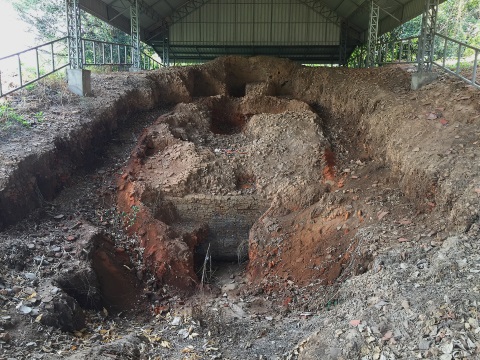
Kiln 2 Within the temple grounds, there is an actual kiln and workshop where duplicates of the artefacts are made for display purposes and for the souvenir shop. 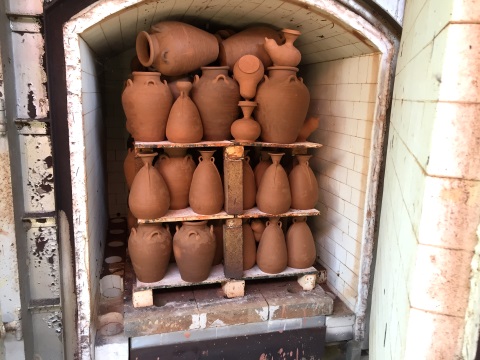
Modern kiln in the workshop Lastly Lung took us to another building where the real artefacts are kept under lock and key. These are actual pieces of pottery that were recovered from the excavation and displayed on the second floor of the building. Let’s take a look at the exhibits in this hall. 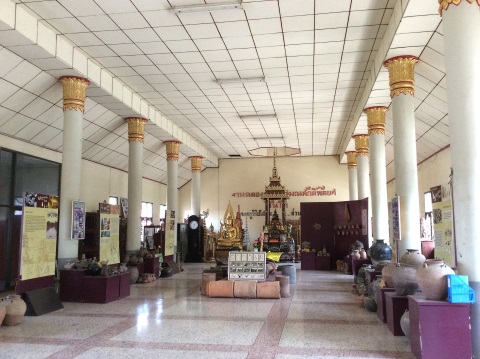
The display hall upstairs 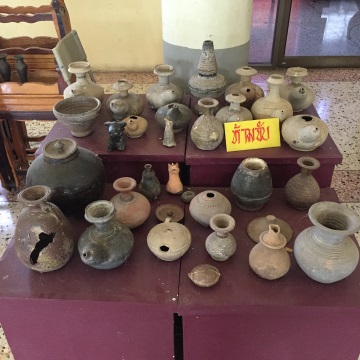
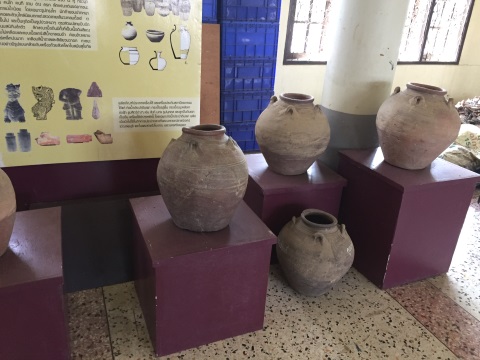

A wide range of different pots and jars 
Jar with ornate decoration on the surface 
More of the four-lug jars These sculptures featuring the Makara, a mythical Hindu creature with the head of a land animal and a body of a sea creature, remind me of some of the displays in the Ancient kilns in Ban Ko Noi, Si Satchanalai The Thai version is called Makara Singh (singh - lion) and is mainly used for decoration of buildings. 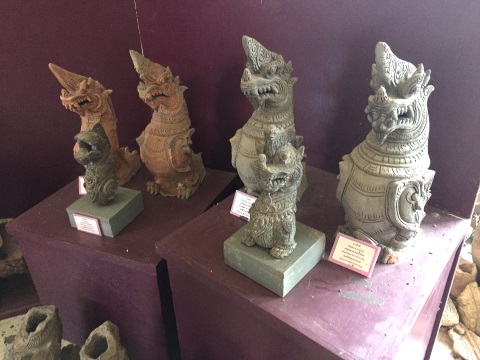
Makara 
Clay pipes used in supply water Here are two versions of an item from the ancient kitchen, the common kitchen stove. In the first photo, the fuel in placed in the cylinder below and the pot placed on to top. The holes are for the smoke to escape. In the second picture, the fuel is placed in the bowl and the pot placed on top. The smoke is released through the funnel. 

Ancient stoves We mentioned earlier that these kilns even produced cannonballs. These were in all likelihood meant for grapeshot, a mass of metal balls fired from a cannon at close range against infantry assaults. In the European versions, canvas bags, tin or brass containers were used to hold the metal pieces. The containers are meant to be fragile so that they break on firing the cannon to release the mass of metal shot. 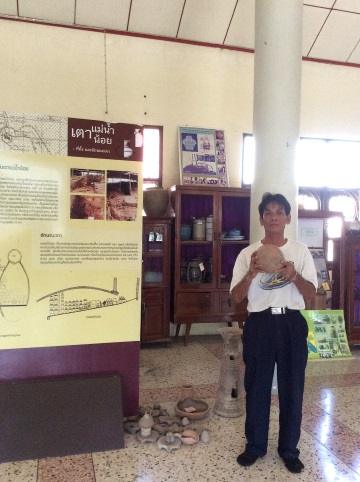
Lung with a clay cannonball Many pieces of pottery were broken and kept in baskets or just piled up in a corner. It’s a pity that such items of historical value can’t be restored, preserved and displayed in a proper museum which can afford the facilities. 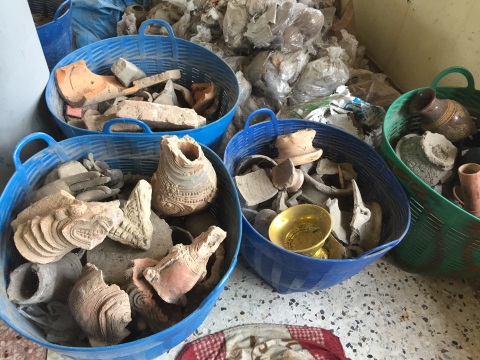
Broken pieces of pottery We dropped in to the souvenir shop to round off our tour of the Maenam Noi kilns to pick up a memento for our visit. 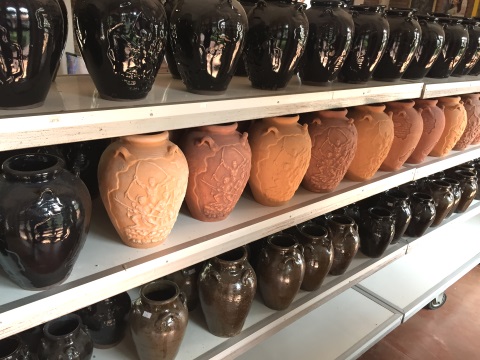
Jars in the souvenir shop – buy some home These ancient kilns on the banks of the Maenam Noi have been in operation since the mid-1400’s and continued to supply pottery till the destruction of Ayutthaya in 1767 AD. They remained buried until they were discovered in the late 20th C. It is fortunate that at least some of the kilns have been preserved and not lost to posterity. Contents Our thanks Our sincere to the administrators of the Maenam Noi Kiln site for the visit and for the information provided in writing this article. In particular we are grateful to Lung for showing us around the kilns, exhibits and temple grounds and for his detailed knowledge on the subject. The visit wouldn’t have been the same without him. He is indeed a credit to Wat Phra Prang. 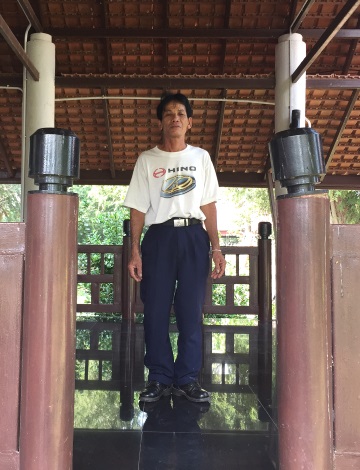
A big thank you to Lung Contents Map to Wat Phra Prang, Singburi If the map doesn’t appear, click on this link How to get there By car Proceed along Highway 32, the main highway linking Bangkok – Ayutthaya – Ang Thong – Singburi. Get off at Route 3026 that links to Singburi City, then onto Route 3030. Cross the Noi River at Bang Rachan Town and get on to Route 3454 where Wat Phra Prang is located. Address Ancient kilns of Maenam Noi Wat Phra Prang Mu Ban Koh Moh Mu 7 Tambon Cherng Klat Amphur Bang Rachan Singburi 16130 Opening hours and admission fees Every day from 0830 – 1630 hours Admission is free Contents Next month The Snakehead fish of Mae La, Singburi If you enjoyed reading this e-zine, please forward it to a friend. If you received this from a friend and found it interesting, please subscribe at Bangkok Travelbug. What do you think of the Bangkok Travelbug? We love to hear from you What other subscribers have said Till next month then. Eric Lim Tour Bangkok Legacies Find us on Facebook Copyright@2008-2017 Tour Bangkok Legacies All rights reserved |
| Back to Back Issues Page |
